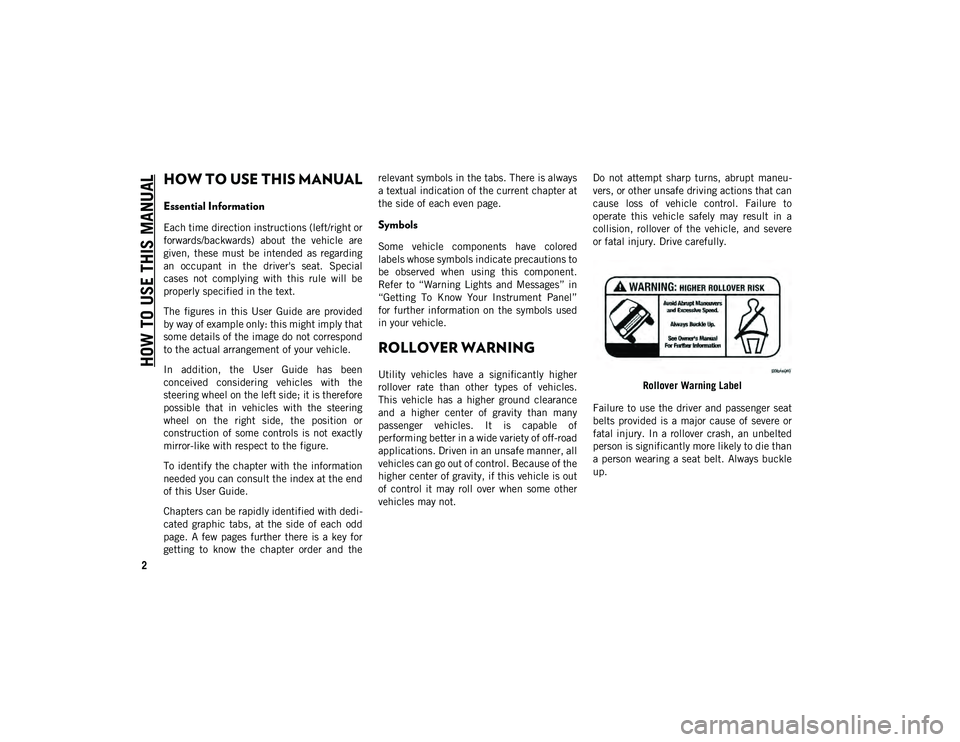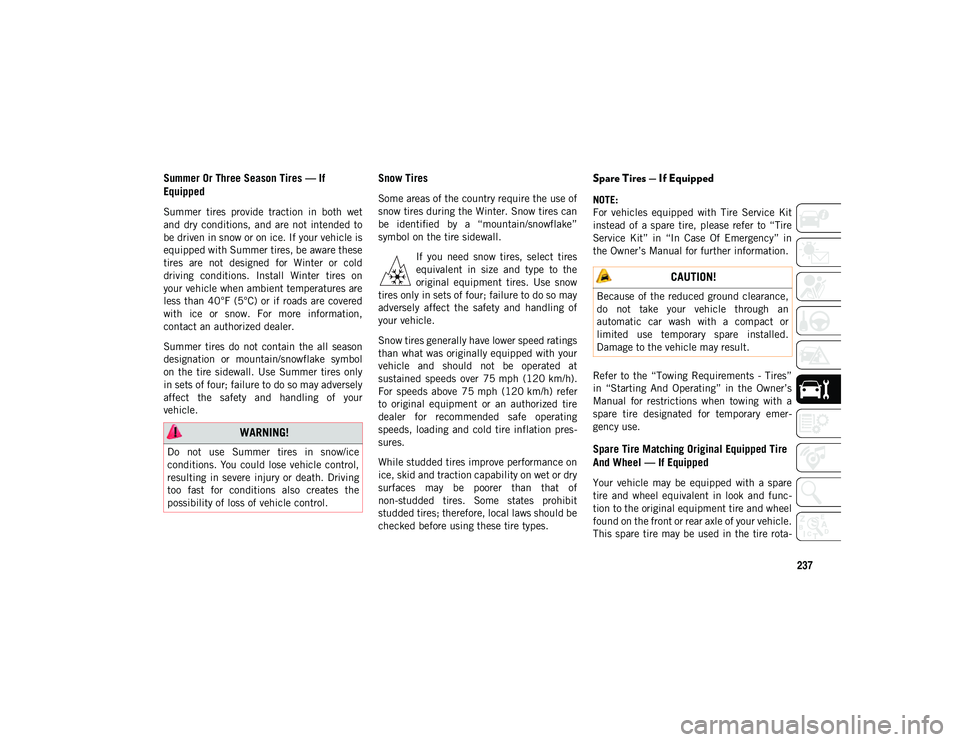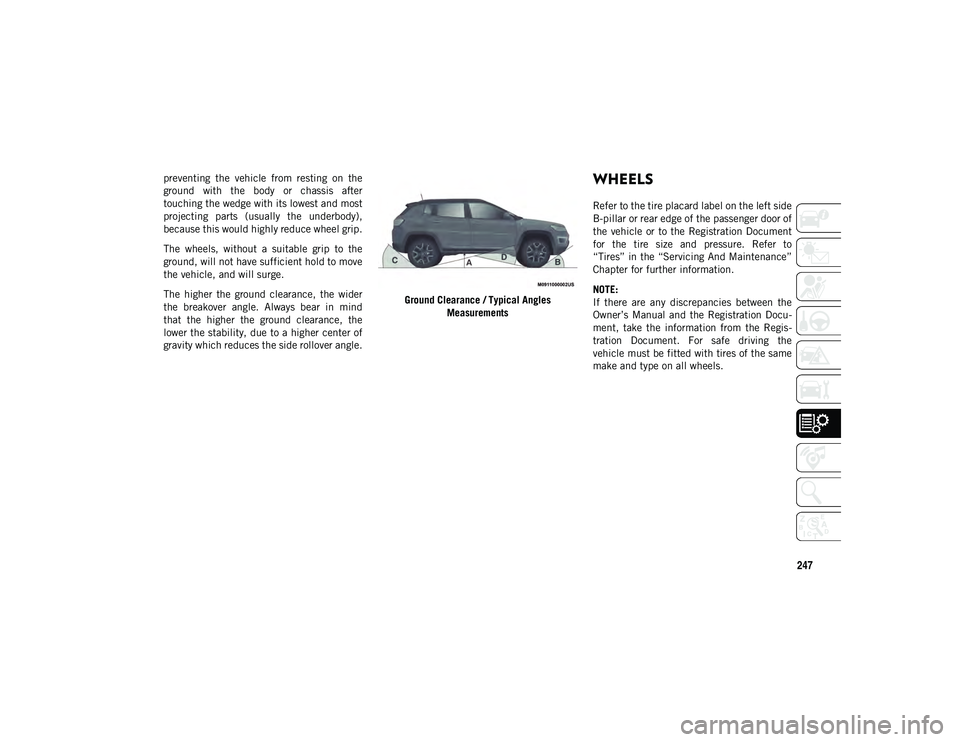ground clearance JEEP COMPASS 2020 Owner handbook (in English)
[x] Cancel search | Manufacturer: JEEP, Model Year: 2020, Model line: COMPASS, Model: JEEP COMPASS 2020Pages: 328, PDF Size: 8.85 MB
Page 4 of 328

2
HOW TO USE THIS MANUAL
HOW TO USE THIS MANUAL
Essential Information
Each time direction instructions (left/right or
forwards/backwards) about the vehicle are
given, these must be intended as regarding
an occupant in the driver's seat. Special
cases not complying with this rule will be
properly specified in the text.
The figures in this User Guide are provided
by way of example only: this might imply that
some details of the image do not correspond
to the actual arrangement of your vehicle.
In addition, the User Guide has been
conceived considering vehicles with the
steering wheel on the left side; it is therefore
possible that in vehicles with the steering
wheel on the right side, the position or
construction of some controls is not exactly
mirror-like with respect to the figure.
To identify the chapter with the information
needed you can consult the index at the end
of this User Guide.
Chapters can be rapidly identified with dedi-
cated graphic tabs, at the side of each odd
page. A few pages further there is a key for
getting to know the chapter order and the relevant symbols in the tabs. There is always
a textual indication of the current chapter at
the side of each even page.Symbols
Some vehicle components have colored
labels whose symbols indicate precautions to
be observed when using this component.
Refer to “Warning Lights and Messages” in
“Getting To Know Your Instrument Panel”
for further information on the symbols used
in your vehicle.
ROLLOVER WARNING
Utility vehicles have a significantly higher
rollover rate than other types of vehicles.
This vehicle has a higher ground clearance
and a higher center of gravity than many
passenger vehicles. It is capable of
performing better in a wide variety of off-road
applications. Driven in an unsafe manner, all
vehicles can go out of control. Because of the
higher center of gravity, if this vehicle is out
of control it may roll over when some other
vehicles may not.
Do not attempt sharp turns, abrupt maneu
-
vers, or other unsafe driving actions that can
cause loss of vehicle control. Failure to
operate this vehicle safely may result in a
collision, rollover of the vehicle, and severe
or fatal injury. Drive carefully.
Rollover Warning Label
Failure to use the driver and passenger seat
belts provided is a major cause of severe or
fatal injury. In a rollover crash, an unbelted
person is significantly more likely to die than
a person wearing a seat belt. Always buckle
up.
2020_JEEP_M6_UG_UK.book Page 2
Page 239 of 328

237
Summer Or Three Season Tires — If
Equipped
Summer tires provide traction in both wet
and dry conditions, and are not intended to
be driven in snow or on ice. If your vehicle is
equipped with Summer tires, be aware these
tires are not designed for Winter or cold
driving conditions. Install Winter tires on
your vehicle when ambient temperatures are
less than 40°F (5°C) or if roads are covered
with ice or snow. For more information,
contact an authorized dealer.
Summer tires do not contain the all season
designation or mountain/snowflake symbol
on the tire sidewall. Use Summer tires only
in sets of four; failure to do so may adversely
affect the safety and handling of your
vehicle.
Snow Tires
Some areas of the country require the use of
snow tires during the Winter. Snow tires can
be identified by a “mountain/snowflake”
symbol on the tire sidewall.If you need snow tires, select tires
equivalent in size and type to the
original equipment tires. Use snow
tires only in sets of four; failure to do so may
adversely affect the safety and handling of
your vehicle.
Snow tires generally have lower speed ratings
than what was originally equipped with your
vehicle and should not be operated at
sustained speeds over 75 mph (120 km/h).
For speeds above 75 mph (120 km/h) refer
to original equipment or an authorized tire
dealer for recommended safe operating
speeds, loading and cold tire inflation pres -
sures.
While studded tires improve performance on
ice, skid and traction capability on wet or dry
surfaces may be poorer than that of
non-studded tires. Some states prohibit
studded tires; therefore, local laws should be
checked before using these tire types.
Spare Tires — If Equipped
NOTE:
For vehicles equipped with Tire Service Kit
instead of a spare tire, please refer to “Tire
Service Kit” in “In Case Of Emergency” in
the Owner’s Manual for further information.
Refer to the “Towing Requirements - Tires”
in “Starting And Operating” in the Owner’s
Manual for restrictions when towing with a
spare tire designated for temporary emer -
gency use.
Spare Tire Matching Original Equipped Tire
And Wheel — If Equipped
Your vehicle may be equipped with a spare
tire and wheel equivalent in look and func -
tion to the original equipment tire and wheel
found on the front or rear axle of your vehicle.
This spare tire may be used in the tire rota -
WARNING!
Do not use Summer tires in snow/ice
conditions. You could lose vehicle control,
resulting in severe injury or death. Driving
too fast for conditions also creates the
possibility of loss of vehicle control.
CAUTION!
Because of the reduced ground clearance,
do not take your vehicle through an
automatic car wash with a compact or
limited use temporary spare installed.
Damage to the vehicle may result.
2020_JEEP_M6_UG_UK.book Page 237
Page 248 of 328

TECHNICAL SPECIFICATIONS
246
Minimum Ground Clearance (Reference A)
The clearance value is measured next to the
lower edge of the differential. This value also
defines those for the “Approach Angle” the
“Departure Angle” and the “Breakover
Angle”.
Dimensions are expressed in inches (mm)
and refer to the vehicle equipped with its
original tires.Approach Angle (Reference B)
The approach angle is determined by the
horizontal line of the road surface, and by the
tangent line passing between the front
wheel, and the most projecting low point of
the car.
The wider the angle, the lower the chance to
hit an obstacle with the body or chassis,
when climbing a steep slope or overcoming
an obstacle.Departure Angle (Reference C)
The departure angle is determined by the
same lines of the “Approach Angle”, and
refers to the rear part of the vehicle.
Breakover Angle (Reference D)
The value of the “Breakover Angle” is linked
to the ground clearance of the vehicle and
indicates the attitude of the vehicle to over
-
come a wedge, more or less steep,
1.4 Mair2 140HP MTX FWD
173.0 (4,394) 80.0 (2,033) 64.1 (1,629) 103.8 (2,636)
1.4 Mair2 170HP ATX AWD 173.0 (4,394) 80.0 (2,033) 64.7 (1,644) 103.8 (2,636)
Minimum Ground Clearance / Typical Angles
Maximum Ground
Clearance –
inches (mm) (A) Approach Angle (B) Departure Angle (C) Breakover Angle (D)
1.6 Multijet 120HP MTX FWD 7.8 (198)0.6 (15.8) 30.8°21.8°
2.0 Multijet 140HP MTX AWD 8.2 (208)0.7 (16.8) 31.7°22.9°
2.0 Multijet 140HP ATX AWD 8.2 (208)0.7 (16.8) 31.7°22.9°
2.0 Multijet 170HP ATX AWD 8.2 (208)0.7 (16.8) 31.7°22.9°
2.0 Multijet 170HP ATX AWD
(TRAILHAWK) 8.5 (216)
1.2 (30.0) 33.6°24.4°
1.4 Mair2 140HP MTX FWD 7.8 (198)0.6 (15.8) 30.8°21.8°
1.4 Mair2 170HP ATX AWD 8.2 (208)0.7 (16.8) 31.7°22.9°
Contour Dimension / inches (mm)
2020_JEEP_M6_UG_UK.book Page 246
Page 249 of 328

247
preventing the vehicle from resting on the
ground with the body or chassis after
touching the wedge with its lowest and most
projecting parts (usually the underbody),
because this would highly reduce wheel grip.
The wheels, without a suitable grip to the
ground, will not have sufficient hold to move
the vehicle, and will surge.
The higher the ground clearance, the wider
the breakover angle. Always bear in mind
that the higher the ground clearance, the
lower the stability, due to a higher center of
gravity which reduces the side rollover angle.Ground Clearance / Typical Angles
MeasurementsWHEELS
Refer to the tire placard label on the left side
B-pillar or rear edge of the passenger door of
the vehicle or to the Registration Document
for the tire size and pressure. Refer to
“Tires” in the “Servicing And Maintenance”
Chapter for further information.
NOTE:
If there are any discrepancies between the
Owner’s Manual and the Registration Docu -
ment, take the information from the Regis -
tration Document. For safe driving the
vehicle must be fitted with tires of the same
make and type on all wheels.
2020_JEEP_M6_UG_UK.book Page 247